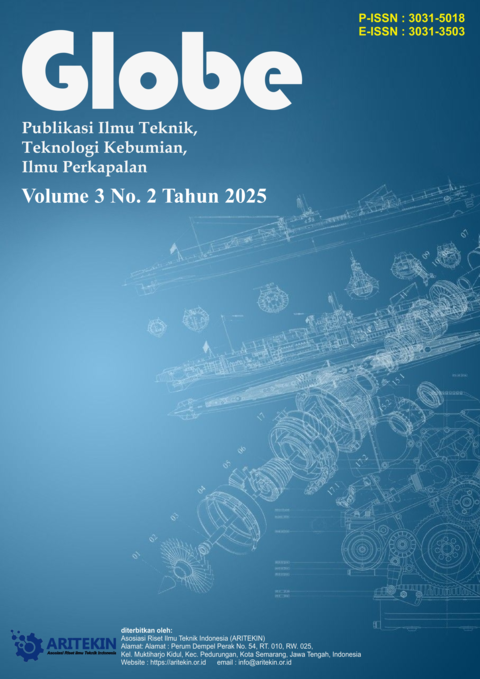Evaluasi Kegagalan Sistem Mitigasi Tsunami: Studi Kasus Tohoku 2011
DOI:
https://doi.org/10.61132/globe.v3i2.797Keywords:
Disaster mitigation, Early warning system, Tohoku 2011 tsunamiAbstract
The 2011 Tohoku tsunami stands as one of the most catastrophic natural disasters in Japan’s history, resulting in massive loss of life, extensive property damage, and severe disruption to infrastructure along the northeastern coast. This study aims to examine the physical characteristics of the Tohoku tsunami and critically evaluate the factors that led to the failure of Japan’s disaster mitigation systems. Utilizing an essay-based synthesis approach, this analysis draws from a range of previous research findings and post-disaster assessments. The tsunami was caused by a 9.0 magnitude megathrust earthquake off the eastern coast of Honshu, generating wave heights that exceeded 10 meters in several locations. The tsunami’s immense energy produced destructive currents that penetrated deep inland, surpassing the protection capabilities of existing coastal defenses.The study identifies several contributing factors to the mitigation system’s shortcomings: the design limitations of seawalls, which were not built to withstand such extreme events; delays and limitations in the early warning system’s ability to reach all at-risk populations in time; and inadequate public preparedness, as the event exceeded historical precedents and training scenarios. These vulnerabilities highlight the need for integrated, adaptive disaster risk management strategies.Drawing lessons from Japan’s experience, this study proposes recommendations for improving tsunami mitigation efforts in Indonesia. Key suggestions include reinforcing and redesigning coastal defense structures, advancing early warning technologies such as seabed sensors and coastal radar systems, and enhancing disaster literacy through public education and scenario-based training. By adopting a science- and technology-driven approach, Indonesia can strengthen its resilience and reduce vulnerability among coastal populations facing future tsunami threats.
References
Aldrich, D. P., & Meyer, M. A. (2015). Social capital and community resilience. American Behavioral Scientist, 59(2), 254–269. https://doi.org/10.1177/0002764214550299
Alexander, D. (2020). Disaster risk reduction. Oxford Research Encyclopedia of Politics, August, 1–23. https://doi.org/10.1093/acrefore/9780190228637.013.1538
Boon, H. J. (2016). Disaster resilience in a flood‐impacted rural Australian town. Natural Hazards, 71(1), 683–701. https://doi.org/10.1007/s11069-013-0935-0
Cutter, S. L., Ash, K. D., & Emrich, C. T. (2014). The geographies of community disaster resilience. Global Environmental Change, 29, 65–77. https://doi.org/10.1016/j.gloenvcha.2014.08.005
Goto, K., Chagué-Goff, C., Goff, J., & Jaffe, B. (2012). The future of tsunami research following the 2011 Tohoku-oki event. Sedimentary Geology, 282, 1–13. https://doi.org/10.1016/j.sedgeo.2012.08.003
Houghton, J. T., Ding, Y., Griggs, D. J., Noguer, M., van der Linden, P. J., Dai, X., Maskell, K., & Johnson, C. A. (2001). Climate change 2001: The scientific basis (1st ed.). The Press Syndicate of the University of Cambridge. https://doi.org/10.1007/9783031259104_264
Japan Meteorological Agency. (2013). Lessons learned from the tsunami disaster caused by the 2011 Great East Japan Earthquake and improvements in JMA’s tsunami warning system. https://www.jma.go.jp
Kelman, I. (2020). Disaster by choice: How our actions turn natural hazards into catastrophes (1st ed.). Oxford University Press. https://global.oup.com/academic/product/disaster-by-choice-9780198841357
Kennett, B. L. N., Gorbatov, A., & Kiser, E. (2011). Structural controls on the Mw 9.0 2011 Offshore-Tohoku earthquake. Earth and Planetary Science Letters, 310(3–4), 462–467. https://doi.org/10.1016/j.epsl.2011.08.039
Koshimura, S., Hayashi, S., & Gokon, H. (2013). Lessons from the 2011 Tohoku earthquake tsunami disaster. Journal of Disaster Research, 8(4), 549–560. https://doi.org/10.20965/jdr.2013.p0549
Lay, T. (2018). A review of the rupture characteristics of the 2011 Tohoku-oki Mw 9.1 earthquake. Tectonophysics, 733, 4–36. https://doi.org/10.1016/j.tecto.2017.09.022
Lay, T., & Kanamori, H. (2011). Insights from the great 2011 Japan earthquake. Physics Today, 64(12), 33–39. https://doi.org/10.1063/PT.3.1361
Mardiatno, D., Malawani, M. N., Annisa, D. N., & Wacano, D. (2017). Review on tsunami risk reduction in Indonesia based on coastal and settlement typology. Indonesian Journal of Geography, 49(2), 186–194. https://doi.org/10.22146/ijg.28406
Rufat, S., Tate, E., Burton, C. G., & Maroof, A. S. (2015). Social vulnerability to floods: Review of case studies and implications for measurement. International Journal of Disaster Risk Reduction, 14, 470–486. https://doi.org/10.1016/j.ijdrr.2015.09.013
Satake, K. (2014). Advances in earthquake and tsunami sciences and disaster risk reduction since the 2004 Indian Ocean tsunami. Geoscience Letters, 1(1), 1–13. https://doi.org/10.1186/s40562-014-0015-7
Suppasri, A., Koshimura, S., Imai, K., Mas, E., Gokon, H., Muhari, A., & Imamura, F. (2012). Damage characteristic and field survey of the 2011 great east Japan tsunami in Miyagi Prefecture. Coastal Engineering Journal, 54(1), 1–30. https://doi.org/10.1142/S0578563412500052
Suppasri, A., Shuto, N., Imamura, F., Koshimura, S., Mas, E., & Yalciner, A. C. (2013). Lessons learned from the 2011 Great East Japan Tsunami: Performance of tsunami countermeasures, coastal buildings, and tsunami evacuation in Japan. Pure and Applied Geophysics, 170(6–8), 993–1018. https://doi.org/10.1007/s00024-012-0511-7
Utami, W. (2022). Post-tsunami land use monitoring to support sustainable coastal management. Jurnal Pengelolaan Sumberdaya Alam dan Lingkungan, 12(2), 186–196. https://doi.org/10.29244/jpsl.12.2.186-196
Widiyantoro, S., Gunawan, E., Muhari, A., Rawlinson, N., Mori, J., Hanifa, N. R., Susilo, S., Supendi, P., Shiddiqi, H. A., Nugraha, A. D., & Putra, H. E. (2020). Implications for megathrust earthquakes and tsunamis from seismic gaps south of Java, Indonesia. Scientific Reports, 10(1), 1–12. https://doi.org/10.1038/s41598-020-72142-z
Downloads
Published
How to Cite
Issue
Section
License
Copyright (c) 2025 Globe: Publikasi Ilmu Teknik, Teknologi Kebumian, Ilmu Perkapalan

This work is licensed under a Creative Commons Attribution-ShareAlike 4.0 International License.






